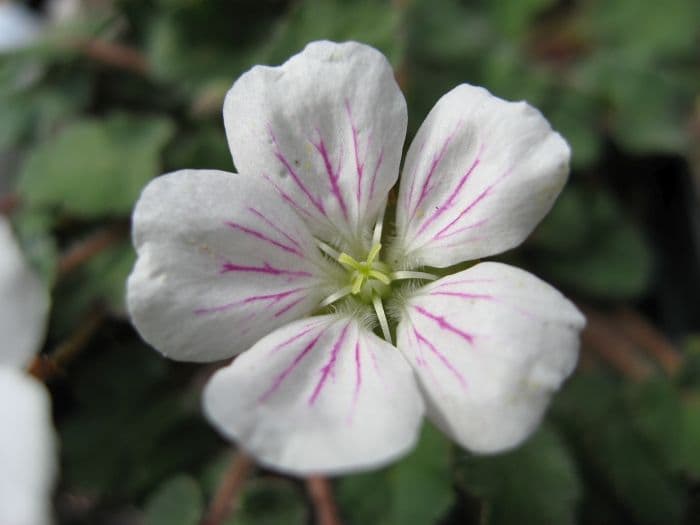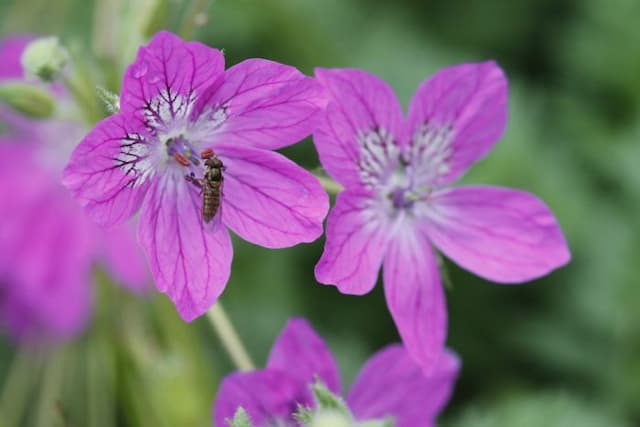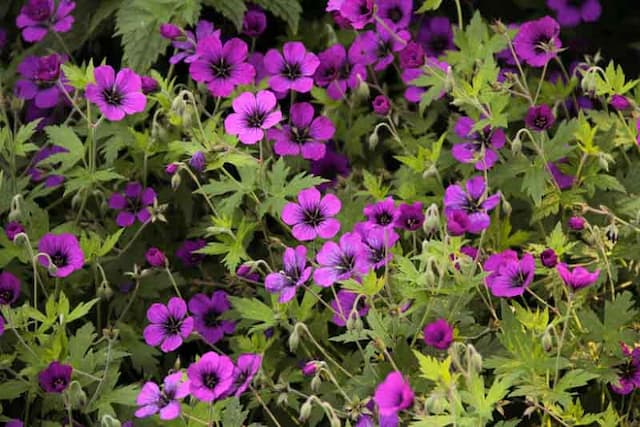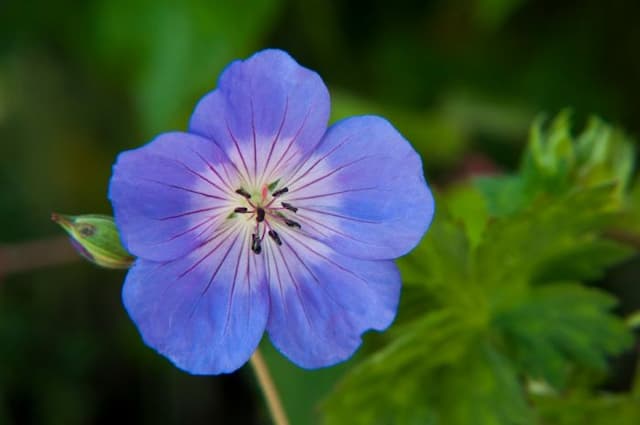Storksbill 'Joe Elliott' Erodium × variabile 'Joe Elliott'

ABOUT
'Album' is a compact, spreading or cushion-forming, perennial to 10cm tall, with mid-green, oval, slightly-lobed leaves and white flowers, with pink veins, that are produced from late spring throughout the summer
About this plant
 Names
NamesFamily
Geraniaceae
Synonyms
Bishop's Form, Storksbill, Bishop's Hat
Common names
Erodium × variabile 'Joe Elliott'.
 Characteristics
CharacteristicsLife cycle
Perennials
Foliage type
Evergreen
Color of leaves
Green
Flower color
Pink
Height
0.5 feet (15 cm)
Spread
1 foot (30 cm)
Plant type
Herb
Hardiness zones
8
Native area
Mediterranean
Benefits
 General Benefits
General Benefits- Attracts Pollinators: The flowers of the Bishop's Hat provide nectar and pollen, which attract bees and other beneficial insects to the garden.
- Low Maintenance: Known for being easy to care for, requiring minimal upkeep once established.
- Drought Tolerant: Once established, it can withstand periods of drought, making it suitable for xeriscaping or water-wise gardening.
- Ground Cover: Its sprawling habit makes it an effective ground cover, which can help reduce weed growth and soil erosion.
- Ornamental Value: It boasts attractive foliage and flowers, adding aesthetic appeal to garden spaces.
- Wildlife Habitat: Provides shelter and breeding places for small wildlife, contributing to biodiversity.
- Seasonal Interest: Offers visual interest throughout its growing season, sometimes with multiple flowering periods.
- Compact Growth: Its relatively small size makes it suitable for containers or small garden spaces.
 Medical Properties
Medical PropertiesThis plant is not used for medical purposes.
 Air-purifying Qualities
Air-purifying QualitiesThis plant is not specifically known for air purifying qualities.
 Other Uses
Other Uses- Erodium × variabile 'Joe Elliott', commonly known as Bishop's Form, can be used as a tool for teaching botany and horticulture due to its interesting hybrid nature and morphology.
- The soft, low-growing foliage of Bishop's Form is ideal for creating fairy gardens or miniature landscapes, offering a fine-textured ground cover.
- This plant serves as a valuable resource for art and photography enthusiasts who appreciate capturing the intricate details of its flowers and leaves.
- Bishop's Form can be used in sensory gardens to provide a tactile experience; its leaves and flowers have a unique texture that can be interesting to touch.
- In culinary arts, while not commonly consumed, the blossoms could be used for decorative purposes, such as garnishing desserts and salads.
- This plant variety can be planted over pet graves as a living memorial, with its perennial nature symbolizing ongoing remembrance.
- The vibrant flowers of Bishop's Form can be used as a natural dye for fabric or paper, offering a subtle range of color depending on the mordant used.
- As an educational tool, this plant can help demonstrate the importance of pollinators, showcasing the relationships between insects and flowering plants.
- Bishop's Form is excellent for creating contrasting textures in pressed flower crafts, holding its color and shape well when dried.
- Creative use in landscape photography can be made by including the ground-hugging Bishop's Form as a foreground element to add depth in compositions.
Interesting Facts
 Feng Shui
Feng ShuiThe Bishop's Hat is not used in Feng Shui practice.
 Zodiac Sign Compitability
Zodiac Sign CompitabilityThe Bishop's Hat is not used in astrology practice.
 Plant Symbolism
Plant Symbolism- Endurance in Adversity: The Erodium × variabile 'Joe Elliott', or heron's bill, exhibits hardiness in various conditions, symbolizing the ability to withstand difficult circumstances.
- Time and Patience: Heron’s bill is known to gradually establish itself and bloom over time, representing the need for patience and the idea that time can bring forth beauty and fulfillment.
- Grace and Elegance: The delicate appearance of the heron’s bill flowers is often seen as a symbol of grace and elegance, akin to the heron bird it is named after.
- Subtlety: With its small and nuanced features, heron's bill can represent an appreciation for the understated or the importance of paying attention to the finer, subtler aspects of life.
 Water
WaterBishop's Form Erodium requires thorough watering when the soil feels dry to the touch, approximately once a week during active growing seasons, spring and summer. Water the plant deeply until water runs through the drainage holes to ensure the roots are sufficiently moistened, which might equate to roughly 1-2 gallons depending on pot size and environmental conditions. In the cooler, dormant months of fall and winter, reduce watering frequency to every other week or when the soil is noticeably dry, as overwatering can lead to root rot. Always check the top inch of soil for dryness before watering to avoid overwatering. It is better to underwater slightly than to overwater, as this species is drought-tolerant.
 Light
LightThe Bishop's Form Erodium thrives best in full sun to partial shade conditions. The ideal spot for this plant would be a location where it could receive at least 6 hours of sunlight daily, while being protected from the harsh afternoon sun that could potentially scorch its leaves. East or west-facing gardens or windows are preferred spots, ensuring it gets plenty of light without the intensity of midday sun.
 Temperature
TemperatureBishop's Form Erodium prefers temperate conditions and generally does well in temperatures ranging from 50°F to 85°F. The plant can survive minimum temperatures down to about 30°F, but frost can damage it, so it is best to protect it or bring it indoors during freezing weather. The ideal temperature range for promoting healthy growth and flowering is between 60°F and 75°F.
 Pruning
PruningPruning the Bishop's Form Erodium helps maintain its shape, encourage bushier growth, and remove spent flowers to promote further blooming. It is best to prune in late winter or early spring before new growth begins, cutting back to just above a set of leaves or a growing node. Prune lightly throughout the year to remove dead or damaged stems and to deadhead, encouraging a tidy appearance and continuous bloom. Pruning can be done every few months or as needed to keep the plant looking its best.
 Cleaning
CleaningAs needed
 Soil
SoilBishop's Hat, or Erodium × variabile 'Joe Elliott', thrives best in well-draining soil enriched with organic matter. The best soil mix can be prepared by combining garden soil, peat, perlite, and compost in equal parts, which ensures adequate drainage and nutrient content. The ideal soil pH for Bishop's Hat is slightly acidic to neutral, ranging from 6.0 to 7.5.
 Repotting
RepottingBishop's Hat does not require frequent repotting and can be done every 2 to 3 years as long as it is not outgrowing its pot or the soil has not degraded.
 Humidity & Misting
Humidity & MistingBishop's Hat is adaptable to a wide range of humidity levels but prefers moderate ambient humidity. There is no specific humidity level required, but it should not be too dry.
 Suitable locations
Suitable locationsIndoor
Place Bishop’s Hat in bright, indirect light and avoid overwatering.
Outdoor
Plant in well-drained soil, full sun to part shade, and water regularly.
Hardiness zone
5-9 USDA
 Life cycle
Life cycleErodium × variabile 'Bishops Form', commonly known as Bishop's Form Storksbill, begins its life cycle when its seeds germinate, usually in the spring after experiencing a period of cold stratification which breaks their dormancy. Seedlings develop a deep taproot and rosettes of leaves, which are key for the survival of young plants as they establish themselves. As the plants mature, they send up flowering stems adorned with five-petalled pink flowers that are typically veined with darker markings, attracting pollinators and leading to the production of fruit. After pollination, fruits develop into distinctive beak-like seed pods that split open to release seeds when mature. This perennial plant can survive through winter, especially in mild climates, retreating back to its basal foliage before repeating the flowering cycle in the subsequent growing season. Bishop's Form Storksbill can also spread by sending out stolons, which are stem-like growths that root at nodes and create new plant clones.
 Propogation
PropogationPropogation time
Spring-Early Summer
The most popular method of propagation for the Erodium × variabile 'Bishop's Form', commonly known as Alpine Geranium, is through division. This process tends to be done in spring or early fall to allow the plants time to establish before the extreme weather conditions of summer heat or winter cold. To propagate through division, the gardener gently lifts the plant from the soil and separates it into several smaller clumps, ensuring that each clump has a portion of the root system. These clumps are then immediately replanted into moist, well-draining soil, at the same depth they were growing previously. It's important to water the new plantings thoroughly to help reduce transplant shock and to settle the soil around the roots.








![Cranesbill [Rothbury Gem]](/_next/image?url=https%3A%2F%2Fplants-admin.emdemapps.com%2Fimages%2Fplants%2F%2Fimages%2F604b6243984c2.png&w=640&q=75)
